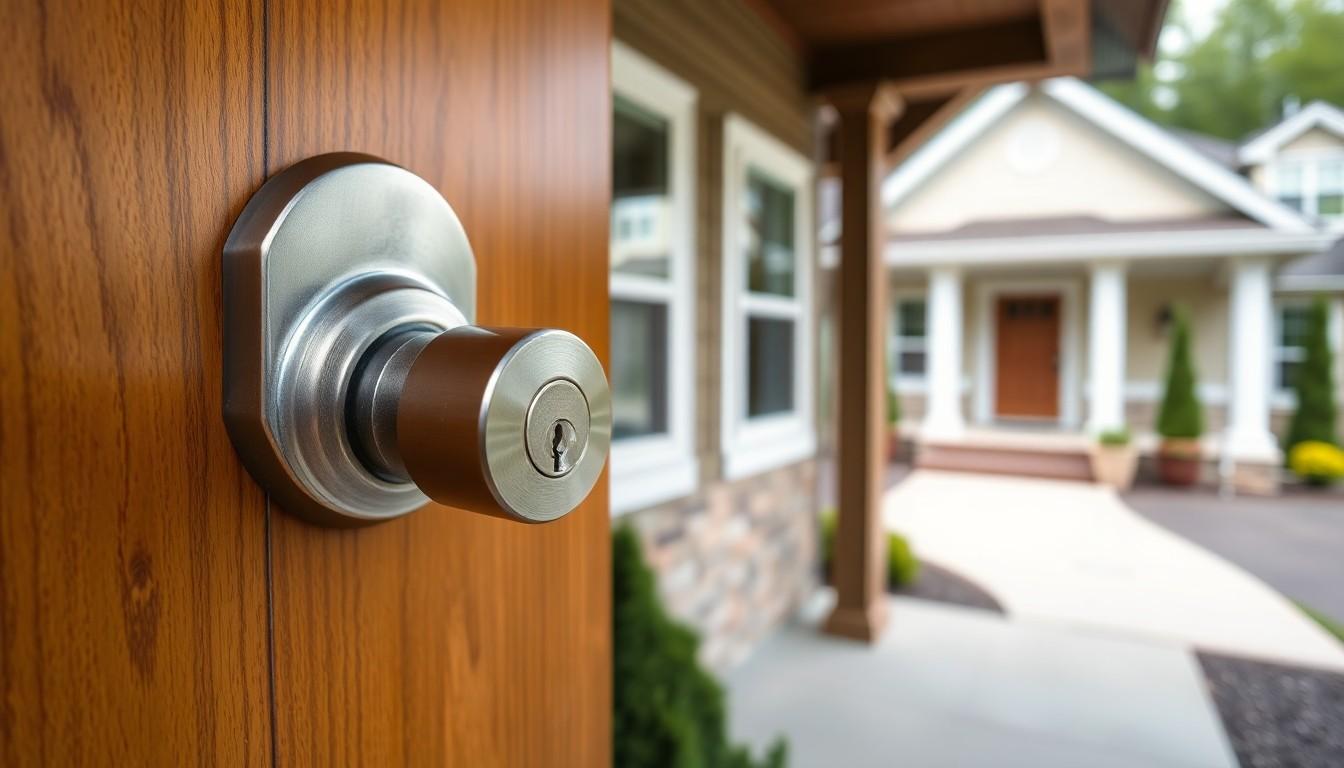In a world where doorbells have more tech than a spaceship, it’s time to ensure that home door security doesn’t take a backseat. After all, a sturdy door is your first line of defense against unwanted guests—especially those who think they can waltz in for a surprise visit. Who needs that kind of drama?
Table of Contents
ToggleImportance Of Home Door Security
Home door security stands as a critical aspect of residential safety. A strong door not only provides an initial barrier against intruders but also enhances overall peace of mind. Statistics show that 34% of burglars enter homes through the front door, emphasizing the need for robust security measures. Reinforcing door frames and installing deadbolt locks significantly reduces the chances of unauthorized entry.
Securing home entrances deters potential criminals. High-quality locks and security cameras serve to make properties less appealing to would-be intruders. Homes with visible security features are 300% less likely to be targeted according to the FBI. Installation of smart locks can add an extra layer of protection while providing convenience through remote accessibility.
An informed homeowner prioritizes door security among other safety initiatives. Regular maintenance of doors and locks ensures function and reliability over time. Using a solid core door or steel door provides enhanced resistance to forced entry, which is essential for effective home protection.
Emergency preparedness also links closely to door security. Planning escape routes and knowing how quickly one can secure doors during emergencies plays an important role in overall safety. Additionally, community awareness contributes to a culture of vigilance, where neighbors help lookout for each other’s properties.
Maintaining strong home door security involves a combination of physical barriers, technological enhancements, and community engagement. Overall security measures create a layered defense strategy, making homes significantly safer for residents and their belongings.
Types Of Home Door Security

Homeowners can select among various options to enhance door security. Understanding these types facilitates informed decisions about protecting residential properties.
Deadbolt Locks
Deadbolt locks offer solid protection against unauthorized entry. These locks come in single and double-cylinder variations, providing added options for security levels. A single-cylinder deadbolt features a key mechanism outside and a turn knob inside. In contrast, double-cylinder deadbolts require a key on both sides, preventing intruders from accessing the lock through a glass panel. Homes equipped with deadbolt locks reduce vulnerability to forced entry, as these locks resist picking and bumping. Installation becomes essential, with a hardware store or professional ensuring proper fitting. They enhance the overall security framework, making door entry significantly more challenging for burglars.
Smart Locks
Smart locks integrate technology into home security. These locks grant access via smartphones, keypads, or biometrics, offering convenience and flexibility. Users can control their smart locks remotely, monitoring entry and exit through mobile apps. Many smart locks include features like alerts, notifying homeowners of suspicious activity. A study reveals that properties with smart locks see lower burglary rates due to their visible deterrence factor. Compatibility with home security systems adds another layer of protection. Regular software updates ensure security against emerging threats, making smart locks a reliable choice for modern homeowners.
Door Reinforcement
Door reinforcement methods enhance a door’s resistance to forced entry. Homeowners can install reinforcement kits that strengthen hinges and create a durable frame. These kits typically include metal plates, screws, and other materials designed to improve structural integrity. A reinforced door withstands significant force, deterring most intruders. Reinforcement proves effective alongside quality locks, creating a formidable defense. Entry points should be clear of vulnerabilities, as burglars often target weak spots. Regular inspections and timely upgrades keep doors secure and contribute to a robust home security strategy.
Tips For Enhancing Door Security
Enhancing door security involves selecting the right locks and employing technology like security cameras. These strategies create a formidable barrier against intruders.
Choosing The Right Lock
Deadbolt locks excel at providing enhanced security, earning their reputation as a top choice for homeowners. Consider single-cylinder deadbolts for standard doors or double-cylinder options for those with glass nearby. The resistance to picking and bumping increases with higher-quality locks, especially those boasting a Grade 1 rating from the American National Standards Institute. Homeowners should also explore smart locks that integrate mobile technology, allowing for secure access and monitoring through smartphones. A robust locking mechanism forms the first line of defense, crucial when statistics reveal that 34% of intruders enter through the front door.
Installing Security Cameras
Security cameras operate as a strong deterrent against potential burglars. Placing cameras at all entry points, especially near doors, provides visible proof of security measures. High-definition cameras equipped with night vision ensure all-day surveillance, increasing peace of mind. Intelligent features, such as motion detection and alerts, allow homeowners to monitor activity in real time. Installation should consider angles that capture faces and license plates for effective identification. Homes with visible security measures reduce burglary attempts by up to 300%, reinforcing the necessity of integrating cameras into the home security framework.
Common Security Threats
Understanding common security threats helps homeowners reinforce their door security effectively. Identifying how intruders operate can significantly fortify defenses.
Burglary Methods
Burglars often use a variety of methods to gain entry. They frequently target front doors, which statistics show are used by 34% of intruders. Common techniques include lock picking and bumping, leveraging tools to unlock doors quietly. Forced entry is seen when assailants kick in doors, especially if they lack reinforcement. Some criminals may impersonate delivery personnel to trick homeowners into opening the door. Awareness of these methods informs security choices, ensuring proper locks and reinforcements are in place.
Vulnerabilities in Door Security
Residential doors often have vulnerabilities that make them easy targets. Inadequate locks, especially standard ones, can lead to unauthorized access. Weak door frames may bend or break under pressure, providing burglars with a point of entry. Often overlooked, hinges on the outside can be easily tampered with if not protected. Homeowners may underestimate the importance of door materials; solid core or steel doors can provide significant resistance to break-ins. Recognizing these vulnerabilities is essential, prompting proactive measures to enhance overall security.
Prioritizing home door security is essential for safeguarding one’s residence. With a significant percentage of burglaries occurring through front doors, implementing robust security measures is crucial. Homeowners should consider investing in high-quality locks and smart technology to bolster protection. Regular maintenance and upgrades to door materials can enhance resistance to forced entry.
Awareness of common vulnerabilities and employing layered defense strategies not only deter criminals but also foster a sense of community vigilance. By taking proactive steps toward door security, residents can create a safer living environment for themselves and their families.



